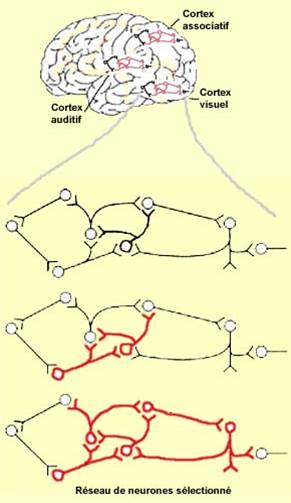Tuesday, 15 May 2018
Memory Engrams: The Physical Traces of Memories in Your Brain

In 1923, German biologist Richard Semon proposed the engram theory of memory. According to this theory, when a person experiences something, a set of selected stimuli from this experience activates entire populations of neurons in that person’s brain, thus inducing lasting chemical and physical changes in their connections. These changes are known as the engram. Each of the assemblies of neurons thus selected thereby contributes to the storage of the memory.
As we shall see in a moment, this was a visionary concept, but Semon’s theory was almost completely ignored until the 1970s, when an article by Daniel Schacter, James Eich, and Endel Tulving brought it back into the scientific discussion.
As these authors pointed out, Semon’s theory anticipated numerous aspects of modern memory research. For example, the engram theory implicitly contains the idea of a recall mechanism called “pattern completion”: if the person whom we we were discussing above encounters just a portion of the original stimuli again, the neurons constituting the engram will be reactivated, thus retrieving the specific memory in question. Two points bear emphasis here. First, when we use the term “reactivate”, all we mean is that the nerve impulses will be traveling preponderantly through these circuits at that given moment. Second, even if the engram is activated only partially (for example, because the stimulus is degraded or slightly different from the original one), that can be enough for the entire assembly of neurons constituting the engram to fire completely, and hence for the memory to be recalled just as completely. It is in this way that one concept or memory can evoke another, which in turn evokes another, and so on.
The engram—the physical substrate of human memory at the cellular level—would thus be the same thing as the networks or assemblies of selected neurons that D.O. Hebb described as “cell assemblies†in 1949.
This in fact is the key hypothesis that has guided exploration of the memory engram, It is summed up in the saying, “Neurons that fire together wire together.” We might also add that “neurons out of sync fail to link” but that’s another story.
So where do things stand with the engram theory today?
Starting in 1973, when Bliss and Lomo discovered the phenomenon of long-term potentiation, researchers began to compile a lot of data about the cellular mechanisms of synaptic plasticity. But no one had managed to identify a connection between the synaptic changes that depend on neural activity and the vast networks of neurons that compose the engram, that are initially activated by specific learning experiences, and whose subsequently reactivation by recall stimuli leads to the appropriate behavioural response.
This is where optogenetics, a technique developed around 2005 and discussed in an earlier post in this blog, came into play. In a paper presented in 2014, Susumu Tonegawa and his team described how they had used optogenetics to clearly identify and even successfully manipulate large assemblies of neurons constituting memory engrams in mice. Before the advent of optogenetics, simultaneously activating the thousands of neurons constituting these assemblies would have been completely impossible. But using optogenetics, Tonegawa’s team successfully caused mice to retrieve specific memories and thus confirmed that this joint activation was sufficient to be regarded as the engram for this memory.
Hence today there is a scientific consensus that the modification of synaptic efficiency through mechanisms such as long-term potentiation and long-term depression represents a fundamental mechanism for the forming of memory engrams distributed across multiple areas of the brain. There is also a consensus that the “synaptic weight” (the efficiency of a synapse) controls the accessibility of the encoded information, and that the particular connectivity of an assembly of neurons controls the specificity of the encoded information.
To sum it all up in simpler terms, when you are studying or training, you are modifying the efficiency of certain synapses in your brain and thus selecting neurons that are going to become”used to working together”. Consequently, your memories are not stored in your brain the way a computer’s memories are stored on a hard drive or a book is stored on a shelf. Your synapses are never exactly the same from one day to the next, because you are using them constantly, and so your memories are necessarily always in the process of being built and rebuilt.
Memory and the Brain | No comments







